Abstract
An animal model for group B streptococcal vaginal colonization and neonatal acquisition was developed with albino rats. Intravaginal inoculation of genital isolates of group B streptococci of serotypes Ia, II, and III either once or on 3 successive days resulted in carriage of the organisms for 7 days or longer in 26% of the virgin animals and 43% of the pregnant animals. Throat and perianal cultures of the offspring of pregnant rats revealed that 51% of the rat pups acquired the organisms at some time. Litter exchange studies were done to explore the contributions of environmental and intralitter spread. Significantly more infants born to mothers with positive vaginal cultures acquired the organisms than infants of culture-negative mothers who were suckled by positive adoptive mothers. However, 13% of the offsprinital cultures acquired group B streptococci. This model may be valuable in understanding the dynamics of vaginal carriage and mother-infant transmission of group B streptococci.
Full text
PDF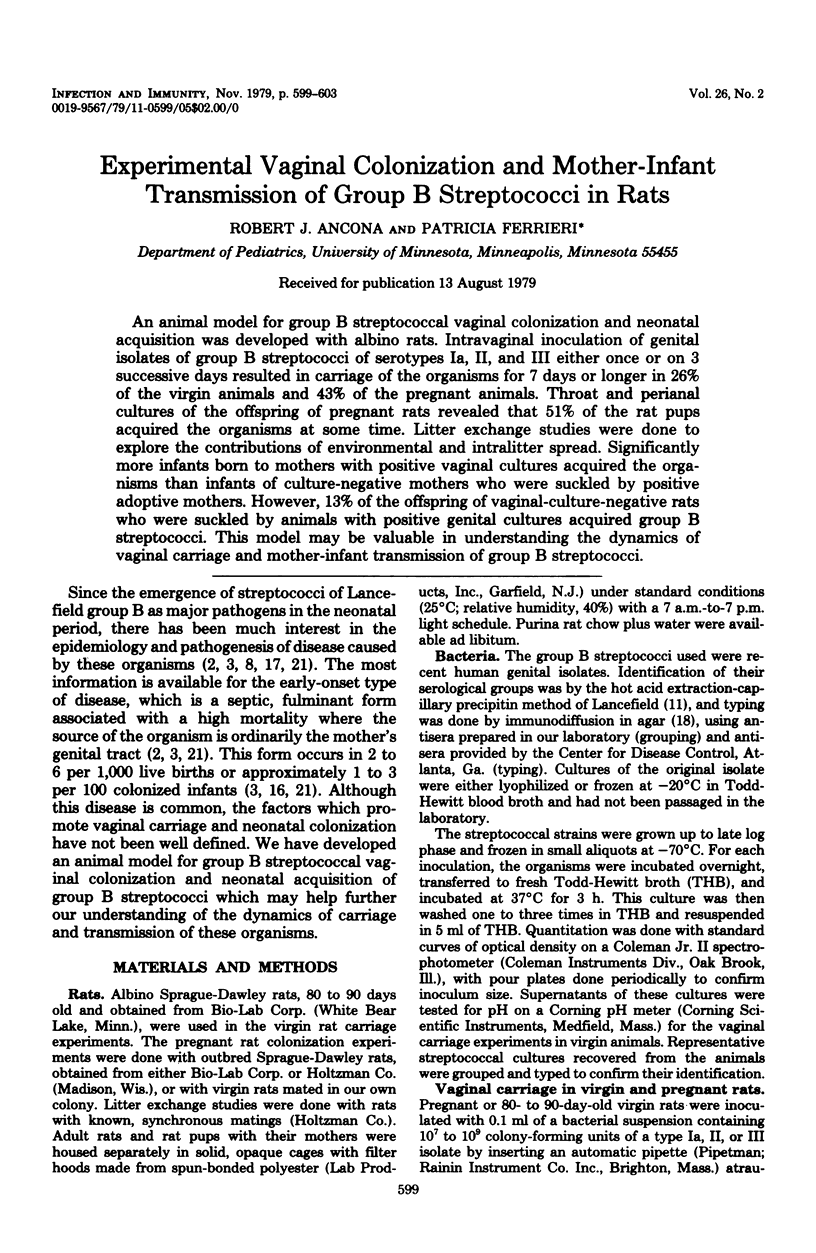
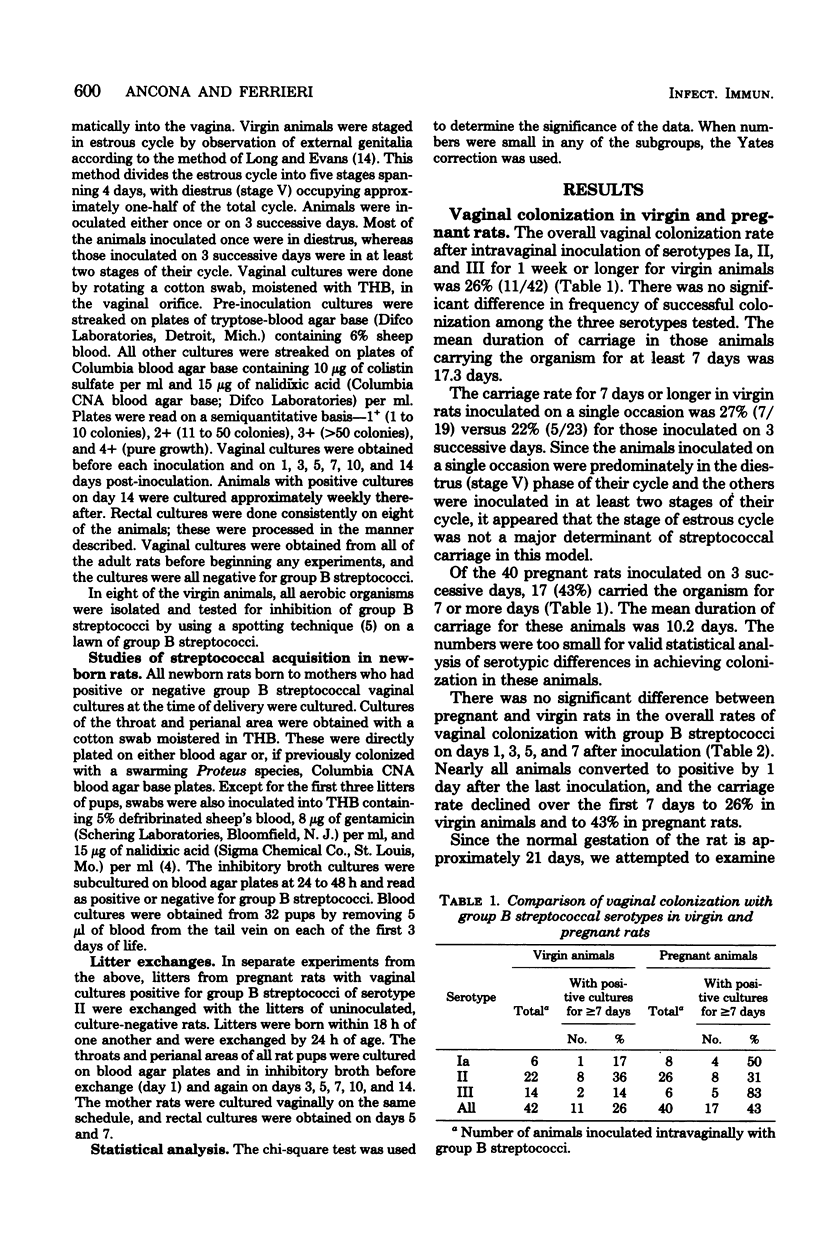
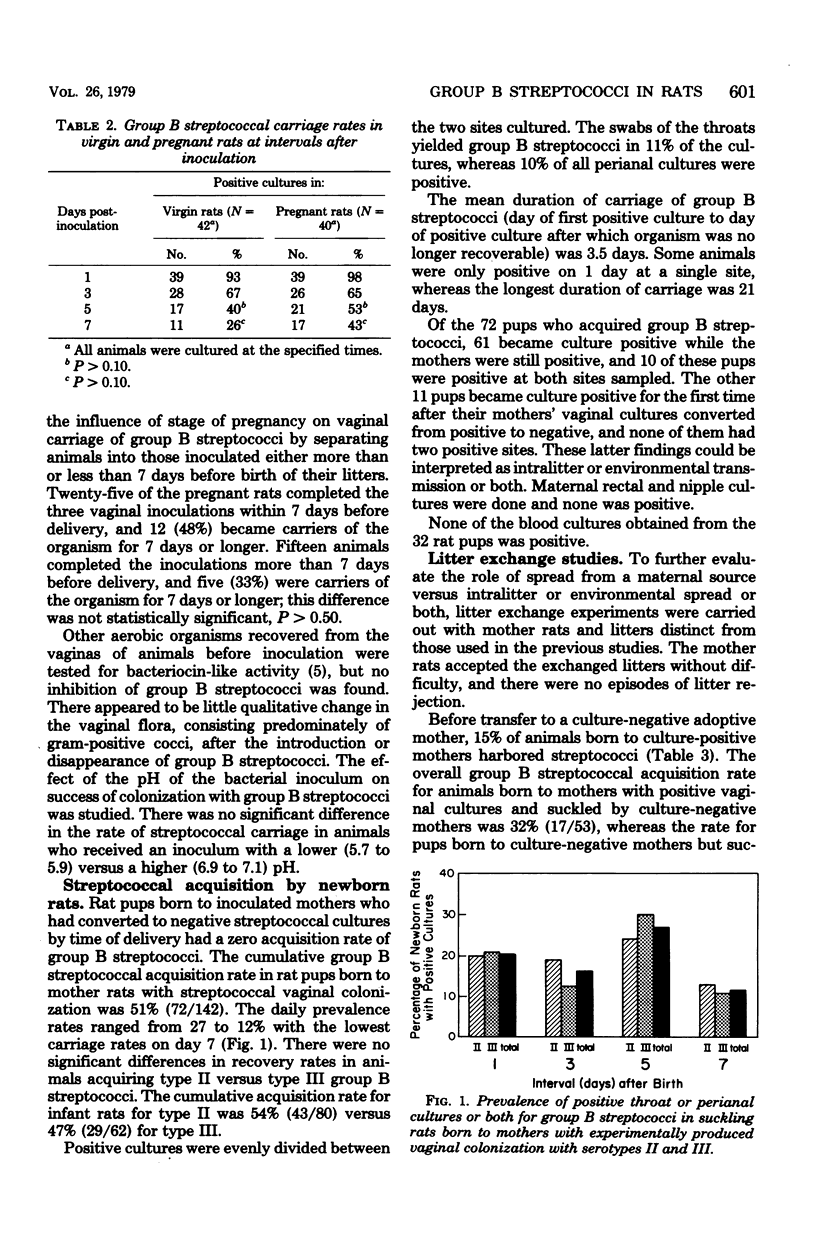
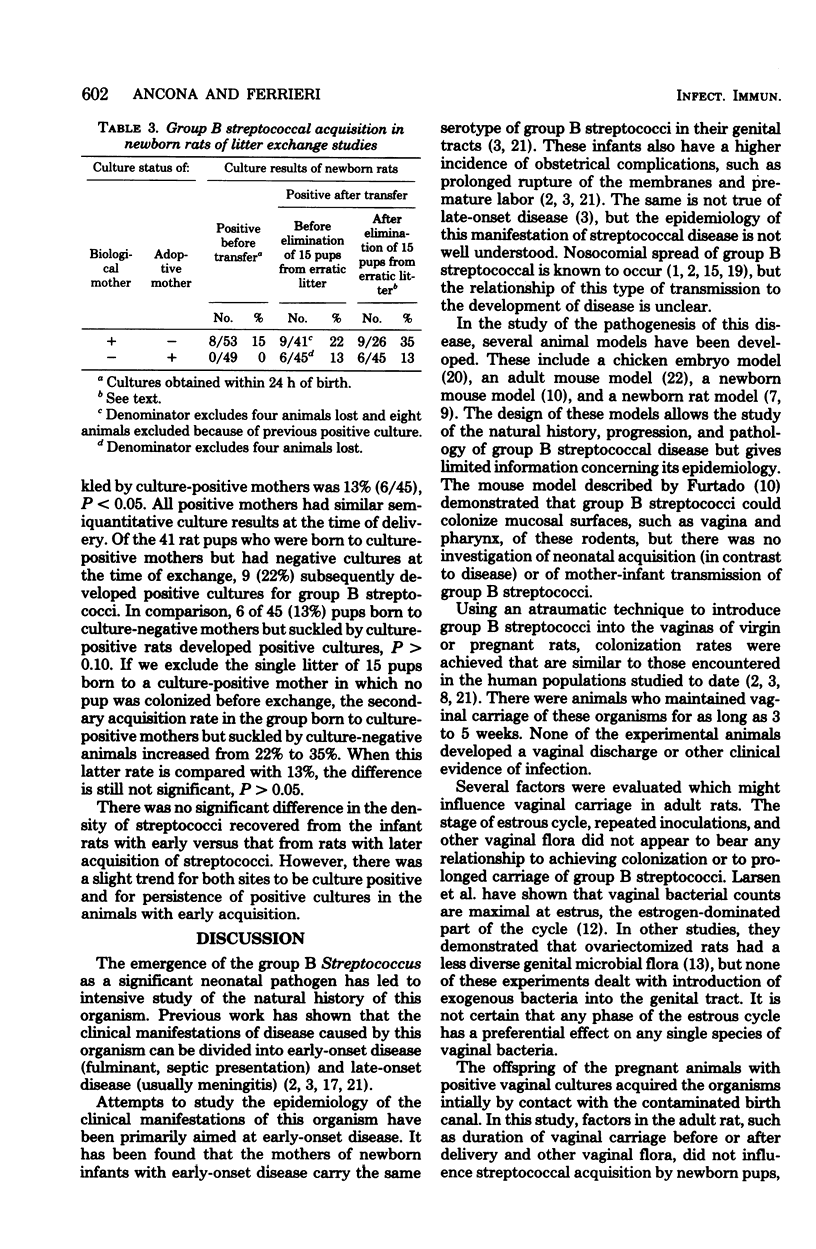
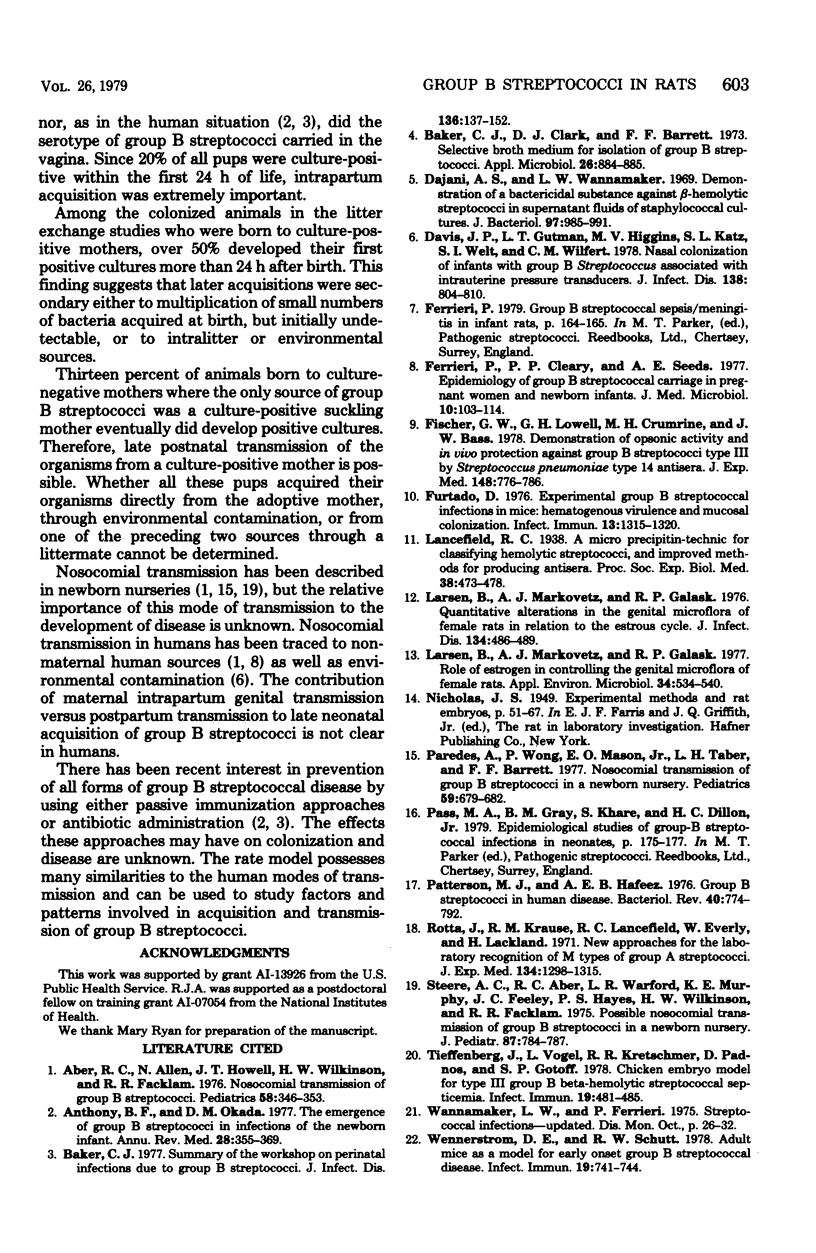
Selected References
These references are in PubMed. This may not be the complete list of references from this article.
- Aber R. C., Allen N., Howell J. T., Wilkenson H. W., Facklam R. R. Nosocomial transmission of group B streptococci. Pediatrics. 1976 Sep;58(3):346–353. [PubMed] [Google Scholar]
- Anthony B. F., Okada D. M. The emergence of group B streptococci in infections of the newborn infant. Annu Rev Med. 1977;28:355–369. doi: 10.1146/annurev.me.28.020177.002035. [DOI] [PubMed] [Google Scholar]
- Baker C. J., Clark D. J., Barrett F. F. Selective broth medium for isolation of group B streptococci. Appl Microbiol. 1973 Dec;26(6):884–885. doi: 10.1128/am.26.6.884-885.1973. [DOI] [PMC free article] [PubMed] [Google Scholar]
- Dajani A. S., Wannamaker L. W. Demonstration of a bactericidal substance against beta-hemolytic streptococci in supernatant fluids of staphylococcal cultures. J Bacteriol. 1969 Mar;97(3):985–991. doi: 10.1128/jb.97.3.985-991.1969. [DOI] [PMC free article] [PubMed] [Google Scholar]
- Davis J. P., Gutman L. T., Higgins M. V., Katz S. L., Welt S. I., Wilfert C. M. Nasal colonization of infants with group B Streptococcus associated with intrauterine pressure transducers. J Infect Dis. 1978 Dec;138(6):804–810. doi: 10.1093/infdis/138.6.804. [DOI] [PubMed] [Google Scholar]
- Ferrieri P., Cleary P. P., Seeds A. E. Epidemiology of group-B streptococcal carriage in pregnant women and newborn infants. J Med Microbiol. 1977 Feb;10(1):103–114. doi: 10.1099/00222615-10-1-103. [DOI] [PubMed] [Google Scholar]
- Fischer G. W., Lowell G. H., Crumrine M. H., Bass J. W. Demonstration of opsonic activity and in vivo protection against group B streptococci type III by Streptococcus pneumoniae type 14 antisera. J Exp Med. 1978 Sep 1;148(3):776–786. doi: 10.1084/jem.148.3.776. [DOI] [PMC free article] [PubMed] [Google Scholar]
- Furtado D. Experimental group B streptococcal infections in mice: hematogenous virulence and mucosal colonization. Infect Immun. 1976 May;13(5):1315–1320. doi: 10.1128/iai.13.5.1315-1320.1976. [DOI] [PMC free article] [PubMed] [Google Scholar]
- Larsen B., Markovetz A. J., Galask R. P. Quantitative alterations in the genital microflora of female rats in relation to the estrous cycle. J Infect Dis. 1976 Nov;134(5):486–489. doi: 10.1093/infdis/134.5.486. [DOI] [PubMed] [Google Scholar]
- Larsen B., Markovetz A. J., Galask R. P. Role of estrogen in controlling the genital microflora of female rats. Appl Environ Microbiol. 1977 Nov;34(5):534–540. doi: 10.1128/aem.34.5.534-540.1977. [DOI] [PMC free article] [PubMed] [Google Scholar]
- Paredes A., Wong P., Mason E. O., Jr, Taber L. H., Barrett F. F. Nosocomial transmission of group B Streptococci in a newborn nursery. Pediatrics. 1977 May;59(5):679–682. [PubMed] [Google Scholar]
- Patterson M. J., El Batool Hafeez A. Group B streptococci in human disease. Bacteriol Rev. 1976 Sep;40(3):774–792. doi: 10.1128/br.40.3.774-792.1976. [DOI] [PMC free article] [PubMed] [Google Scholar]
- Rotta J., Krause R. M., Lancefield R. C., Everly W., Lackland H. New approaches for the laboratory recognition of M types of group A streptococci. J Exp Med. 1971 Nov 1;134(5):1298–1315. doi: 10.1084/jem.134.5.1298. [DOI] [PMC free article] [PubMed] [Google Scholar]
- Steere A. C., Aber R. C., Warford L. R., Murphy K. E., Feeley J. C., Hayes P. S., Wilkinson H. W., Facklam R. R. Possible nosocomial transmission of group B streptococci in a newborn nursery. J Pediatr. 1975 Nov;87(5):784–787. doi: 10.1016/s0022-3476(75)80311-8. [DOI] [PubMed] [Google Scholar]
- Summary of the workshop on perinatal infections due to group B Streptococcus. J Infect Dis. 1977 Jul;136(1):137–152. doi: 10.1093/infdis/136.1.137. [DOI] [PubMed] [Google Scholar]
- Tieffenberg J., Vogel L., Kretschmer R. R., Padnos D., Gotoff S. P. Chicken embryo model for type III group B beta-hemolytic streptococcal septicemia. Infect Immun. 1978 Feb;19(2):481–485. doi: 10.1128/iai.19.2.481-485.1978. [DOI] [PMC free article] [PubMed] [Google Scholar]
- Wennerstrom D. E., Schutt R. W. Adult mice as a model for early onset group B streptococcal disease. Infect Immun. 1978 Feb;19(2):741–744. doi: 10.1128/iai.19.2.741-744.1978. [DOI] [PMC free article] [PubMed] [Google Scholar]


